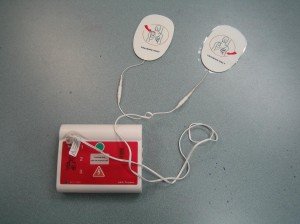An AED or automated external defibrillator is a portable device that monitors the rhythm of the heart. If required, it can deliver an electric shock to the heart in an attempt to restore the normal rhythm. These devices are used to treat sudden cardiac arrest which is a condition where the heart abruptly stops beating. Once this occurs, the blood flow to the brain and vital organs stops as well as leading to death if not treated right away. By using the device on an individual suffering from a sudden cardiac arrest, it can save a life.
How the heart works
In order to fully understand how AEDs work, it is important to fully understand how the heart works.
The heart is built with an internal electrical system that controls the rhythm and rate of the heartbeat. With every heartbeat, an electrical signal spreads from the top part of the heart and to the bottom. As the signal travels, the heart will contract and pumps out blood. This process is repeated with every heartbeat.
Any problems with the electrical system will lead to abnormal heart rhythms known as arrhythmias. During an arrhythmia, the heart can either beat too fast or too slow or with a rhythm that is irregular. In some, the arrhythmia can cause the heart to stop pumping blood and can cause sudden cardiac arrest.
Causes of sudden cardiac arrest
The common cause of sudden cardiac arrest is an arrhythmia known as ventricular fibrillation in which the ventricles no longer beat normally but quiver quickly and irregularly. Another arrhythmia that can lead to sudden cardiac arrest is ventricular tachycardia which is fast regular beating of the ventricles that can last for a few seconds or longer.
Individuals who have these arrhythmias can receive an electric shock from an AED in order to restore the normal rhythm of the heart. Performing CPR on an individual having a sudden cardiac arrest will also improve the chance of survival.
An introduction to AEDs
AEDs are light in weight, battery-operated, transportable devices that are easy to use. Every unit includes instructions and has voice prompts that informs you when to deliver a shock to the heart.

It is important to learn how to use an AED and CPR in a first aid course. Nevertheless, if a trained individual is not available, untrained individuals can also use an AED to save a life.
AEDs are often available in venues with many individuals such as golf courses, shopping malls, airports, businesses, airplanes, hotels, convention centers, sports venues and schools. For home or office use, you can even purchase a home-use AED.
Always bear in mind that a high percentage of individuals who suffer from sudden cardiac arrest die in just a matter of minutes. The rapid treatment of sudden cardiac arrest using an AED can help save a life.
